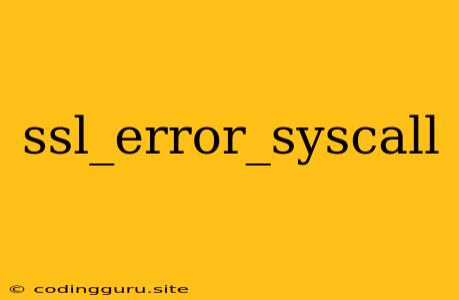The "ssl_error_syscall" Error: A Troubleshooting Guide
Have you encountered the dreaded "ssl_error_syscall" error while browsing the web? This error message often pops up when attempting to access websites secured with HTTPS, indicating that there's a problem with the secure connection setup. This issue can stem from various factors, ranging from network connectivity hiccups to more complex system configurations.
Let's delve into understanding this error and explore solutions to get you back on track.
What is "ssl_error_syscall"?
At its core, "ssl_error_syscall" suggests that there's a failure in the underlying system calls responsible for establishing a secure SSL/TLS connection. These system calls are low-level functions that handle communication between your browser and the website's server.
Common Causes:
- Network Issues: Poor internet connectivity, unstable Wi-Fi, or network firewalls can disrupt the connection establishment process.
- System Configuration Errors: Incorrectly configured DNS settings, proxy server settings, or outdated system libraries can interfere with SSL/TLS connections.
- Firewall Blocking: Your firewall might be blocking the necessary ports for secure communication.
- Certificate Problems: Invalid or expired SSL certificates on the website can also trigger this error.
- Browser Bugs or Extensions: Sometimes, browser extensions or even browser bugs themselves can interfere with secure connections.
- Server-Side Problems: The website server itself might have issues related to its SSL/TLS configuration.
Troubleshooting Steps
Here's a step-by-step approach to resolving the "ssl_error_syscall" error:
1. Restart Your Browser and Computer:
A simple restart can often resolve temporary glitches and network hiccups.
2. Check Your Internet Connection:
Ensure your internet connection is stable and working. Try accessing other websites to confirm connectivity.
3. Clear Browser Cache and Cookies:
Outdated cache and cookie data can sometimes interfere with SSL connections. Clear your browsing history and cookies in your browser settings.
4. Temporarily Disable Browser Extensions:
Extensions can conflict with SSL/TLS functionalities. Disable all extensions and check if the error persists.
5. Update Your Browser:
Older browser versions might lack compatibility with newer SSL/TLS protocols. Update your browser to the latest version.
6. Check Your Date and Time Settings:
Incorrect system date and time settings can lead to issues with SSL certificates. Ensure your clock is accurately synchronized.
7. Disable Proxy Server:
If you're using a proxy server, temporarily disable it to check if it's causing the problem.
8. Reset DNS Settings:
In Windows, use the command prompt to flush DNS cache: ipconfig /flushdns. In Linux or macOS, run the command sudo dscacheutil -flushcache.
9. Configure Firewall Settings:
Check your firewall settings to ensure it's not blocking the necessary ports for HTTPS communication.
10. Contact Website Administrator (If Possible):
If all else fails, consider contacting the website administrator. They might have issues with their SSL/TLS setup.
Example Scenarios and Solutions:
Scenario 1: You're using a public Wi-Fi network, and you encounter the "ssl_error_syscall" error.
Solution: Public Wi-Fi networks can be unreliable. Try connecting to a more stable network, or consider using a VPN to enhance your security and privacy.
Scenario 2: You've updated your operating system, and now you see the "ssl_error_syscall" error on multiple websites.
Solution: The update might have introduced system configuration changes. Check your network settings, DNS settings, and firewall rules to ensure they are still properly configured.
Scenario 3: You've recently installed a new security software or antivirus program, and you're seeing the error.
Solution: The new software might be interfering with SSL/TLS connections. Temporarily disable the software to check if the error disappears. If it does, you may need to adjust the software's settings or choose a different security solution.
Conclusion
The "ssl_error_syscall" error can be frustrating, but by systematically going through the troubleshooting steps outlined above, you're likely to pinpoint the cause and restore your secure browsing experience. Remember to be patient and methodical in your approach, and don't hesitate to seek assistance from the website administrator or online forums if necessary.
